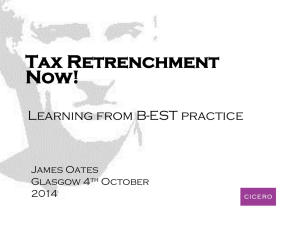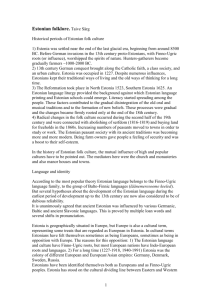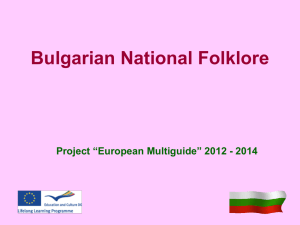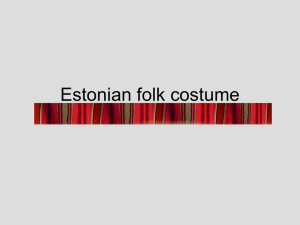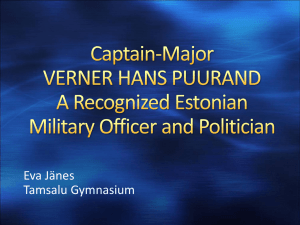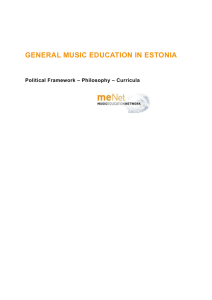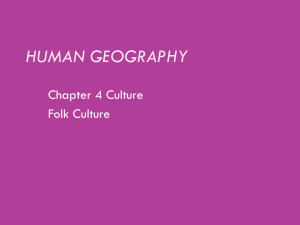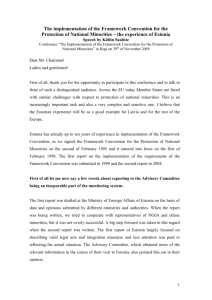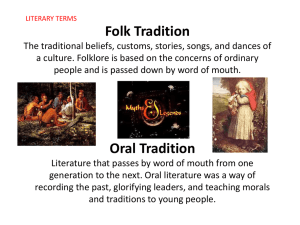text - Folklore.ee
advertisement
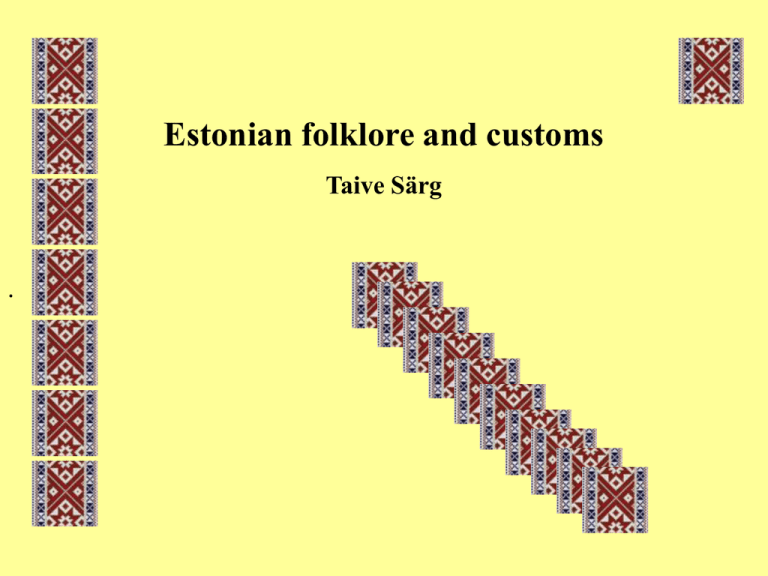
Estonian folklore and customs Taive Särg . Historical periods of folk life start with following historical events. 1. Estonia was settled near the end of the last glacial era 8500 BC. Hunters-gatherers become gradually farmers ~1000-2000 BC. 2. German invasion in the 13th century: Catholic religion, class society. (Estonia was occupied in 1227, serf-ownership started officially in 1671). 3. Reformation in the 16th – 17th century: literacy, schools. (Reformation in North Estonia 1523, Southern Estonia 1625). 4. Economic and social changes in 19th century: abolishing of serfdom (1816,1819) and buying land for freeholds (1860s), modernizing society. Estonian language and identity 1. Estonian belongs to Finno-Ugric language family, the group of Balto-Finnic languages, close language relatives are Finnish, Livonian, Votian, Vepsian, Ingrian, Karelian. 2. Estonian was influenced by various Germanic, Baltic and ancient Slavonic languages. 3. Estonia is geographically situated in Europe, but Europe is also a cultural term, representing some treats that are regarded as European in Estonia. 4. Estonia has received influences from both east and west, Estonians have been identified themselves both as Europeans and as Finno-Ugric peoples. Finno-Ugric peoples Local areal cultures in Estonia. 1. Northern Estonia has more similarities with Finnish and Votian culture. Very special area of Northern culture are islands in Western Estonia. Estonian literary language bases on North and Central Estonian dialects. 2. Southern Estonia seems more ancient today with its rural way of life and dialect, quite different from literary language. Southern Estonian folk culture has Baltic and Slavonic influences. The most distinctive region is Setomaa in southeastern Estonia. It was incorporated to Estonia in 1920, but went back to Russia in 1991. North E South E Setomaa Estonian local areas Southern Estonia by Konrad Mägi 1915-16 Saaremaa island by Konrad Mägi 1913-14 Traditional cultural expression pärimus (*pär + i + mus) vaimne pärimus intangible cultural heritage aineline pärand tangible cultural heritage folklore folkloor ehk rahvaluule folk art rahvakunst discipline: folkloristics folkloristika discipline: ethnology etnoloogia Aesthetic and pragmatic aspects often occure together. Folklore (intangible cultural heritage) includes oral traditions, performing arts, social practices, rituals, festive events, knowledge and practices concerning nature and the universe or the knowledge and skills to produce traditional crafts, “savoir faire” (‘know how’) Folklore • rahvausk folk beliefs – common beliefs that are widely accepted as truth by most members of the group, e.g. old myths about world creation, supernatural beings, but also contemporary superstitions etc. Often beliefs appear in verbal form (proverbs, narratives), they are the bases of customs and rituals, can govern cultural practices. • kombed customs – family traditions, calendar traditions, etc, often combining entertainment and magic • sõnakunst verbal arts – folk songs lyrics, folk narratives, short forms of folklore • rahvamuusika ja -tants folk music and dance– folk song melodies, instrumental pieces, folk dances, games with songs and music Folk art • rahvariided traditional costumes – clothes, shoes, adornments • elutarbed necessaries – tools, furnishing, utensils, vehicles... • rahvustoit national dish – food, drink • ehitised farm architecture – building materials, the types of settlement, farm buildings (barn-dwelling, granary, saun) • rahvapillid folk music instruments • special instruments – magic tools, toys, calendars • kaunistused – decorations, adornments Professional, institutionalized art and religion are not folklore. Estonian Symphony Orchestra Valjala church, Saaremaa island, 13th century Folklore has 3 basic components: group (~folk) text (~lore) context Seto folk singers, The 1960s Folklore group Leegajus in Estonian Open Air Musem in 1980s. historical, cultural background context(s) time, place participants, audience performers text group


